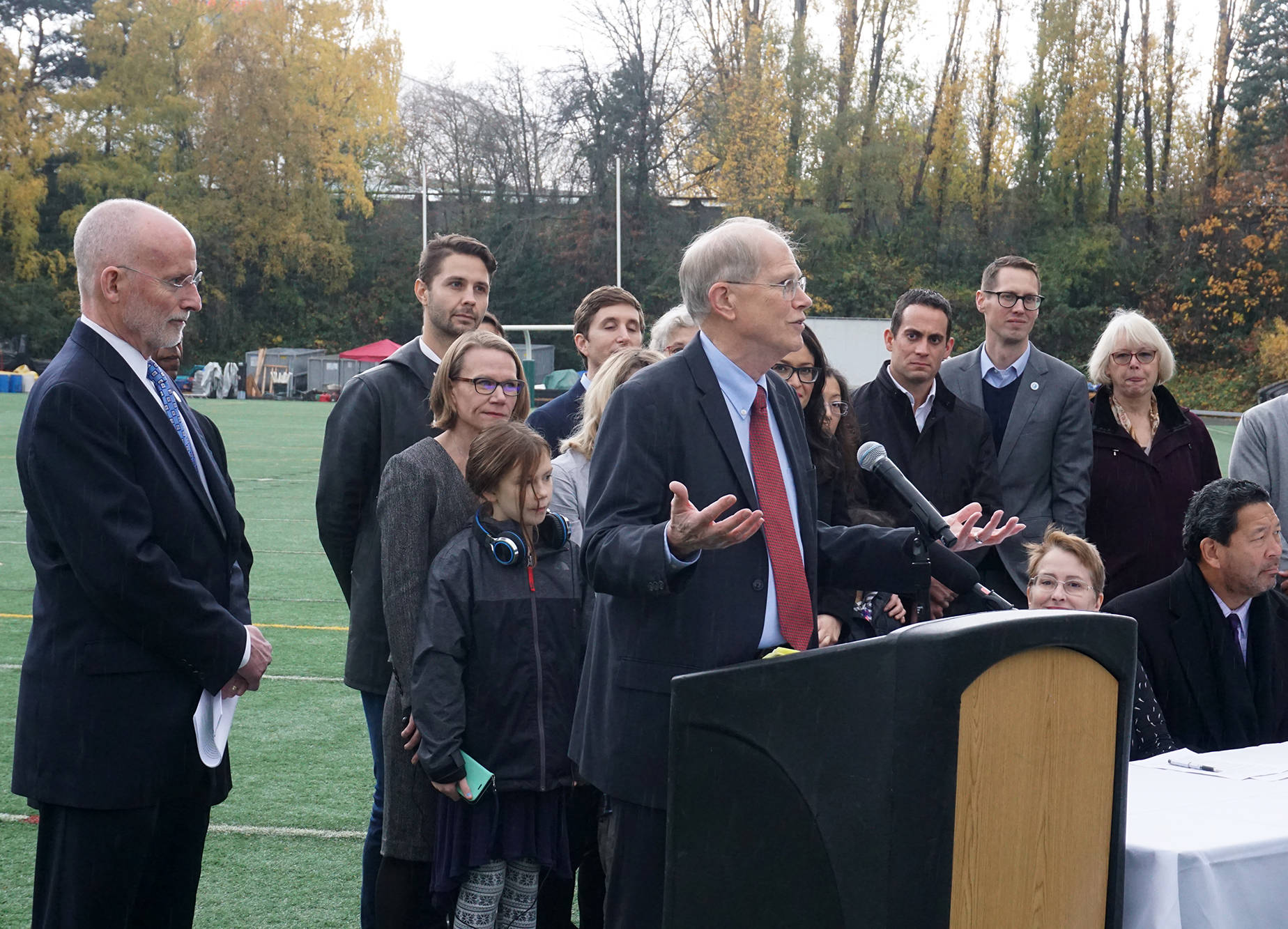On Tuesday evening, about 250 people filtered into the Magnolia United Church of Christ to discuss the city’s use of a former army base that has remained in limbo for nearly a decade. The majority of attendees spoke in favor of creating 238 affordable housing units on 7.3 acres of land at Fort Lawton, which borders Discovery Park and overlooks the Puget Sound.
“So many homeowners in the city, including my neighborhood, are actively resisting growth and change,” said attendee Patricia Akiyama, a Queen Anne resident who has lived in Seattle for 25 years. Reading from her testimony (as show in video footage from The Stranger), Akiyama continued,“It would be a positive development for the city if we could help people understand the benefits of more housing so that they will accept and embrace the change. Let’s support creative ways to build more housing in our neighborhoods offering a variety of living options for people from all walks of life. Housing at Fort Lawton would offer more options for people who work in the city and want to live here.”
Tuesday’s public hearing follows the December 14 release of a 374-page draft Environmental Impact Statement (EIS) of the Fort Lawton Redevelopment Plan. The hearing mostly touched on housing options, baffling members of parent-led group Fort Lawton School Coalition, which has lobbied the school and city to consider using the site for educational facilities. Mention of a partnership between Seattle Public Schools (SPS) and the city to include the school district in the site’s redevelopment plans were largely absent from the conversation on Tuesday.
The draft EIS studied four alternative plans for the site. The preferred alternative — which received the most support during public comments — includes the nearly 240 affordable housing units as well as a vision for Seattle Public Schools. The city’s Strategic Advisor for Housing Policy Lindsay Masters confirmed with Seattle Weekly that the school district is listed as the owner of about six acres of recreational space in the preferred alternative. However, the immediate plan only discusses the district’s use of the land for park space, not as a school site.
“The agreement that we have with the school district and what they’ve communicated as their interest in the near term is that we would be putting park and open space, but that the school district would have a seat at the table and they would have a potential to have ownership over that acreage,” Masters said.
In November 2017, the city entered into a partnership with the school district that agreed SPS would be included in the redevelopment plan, following years of urging from parents concerned about classroom overpopulation. Fort Lawton School Coalition member Valerie Cooper saw November’s partnership as a step in the right direction to address the dearth of school facilities. She and other members had lofty goals of the land being used in part for an environmental school, where the students could use Discovery Park as their laboratory. Yet she left Tuesday’s meeting unsure how the process between the district and the city would play out.
“I had a conversation with one of the members today … He was feeling really worried about is this going to follow through,” Cooper told Seattle Weekly on Wednesday after hearing minimal discussion about a potential educational facility during Tuesday’s hearing.
The draft EIS has been a long time coming. In 2005, the U.S. Army decided to vacate the century-old base and made the city responsible for implementing a redevelopment plan for Fort Lawton. The city originally planned on turning the site into a mixed-income community with permanent housing for homeless people, market-rate homes, and park space. However, the King County courts ordered that the city’s plan had to undergo a state environmental review in 2009, and the city lost its appeal to the ruling in 2010. Part of the site then remained vacant after the army officially closed the Fort Lawton Army Reserve Center in 2012. Then last year, the city entered into a five-year lease agreement with the U.S. Army to assume the maintenance costs of the 34 acres.
If the city follows through with the preferred alternative, the fields owned by the district on the site would initially be used as recreational facilities that wouldn’t exclusively be for student use. “Similar to other park facilities around the city, the most likely scenario is that there would be a joint use agreement between the city and the school district so that in addition to the school being able to use that space, members of the public would also have the opportunity to share the space with them,” Masters clarified.
She called the possibility of an environmental school a “down the line discussion” that would be a different process from that of the draft EIS.
District officials in November stressed the urgent need for new schools, and hope to continue pushing forward with an accommodating plan. At a November press conference on the Memorial Stadium field, School Board Vice President Leslie Harris said that the district was so overpopulated that “we’re bursting at the seems.” Harris added during that conference that SPS has already added 10 new buildings to accommodate the population growth within the past two years, but that it still wasn’t enough.
Cooper hopes that the coalition will find a way to address the lack of sufficient educational facilities through talks with policymakers. “This is the moment, now,” Cooper said. “It really needed to happen years ago as well, but we’d like to catch up as much as we can now so we can prevent ourselves from being in a stronger crisis in the future.”
The Office of Housing will continue taking public comments through January 29, which can be sent to OH_Comments@Seattle.gov. Comments will be reviewed and taken into consideration for the final EIS which will be released in early 2018.
mhellmann@seattleweekly.com
Correction: A previous version of this story misquoted Valerie Cooper. It has been corrected.









